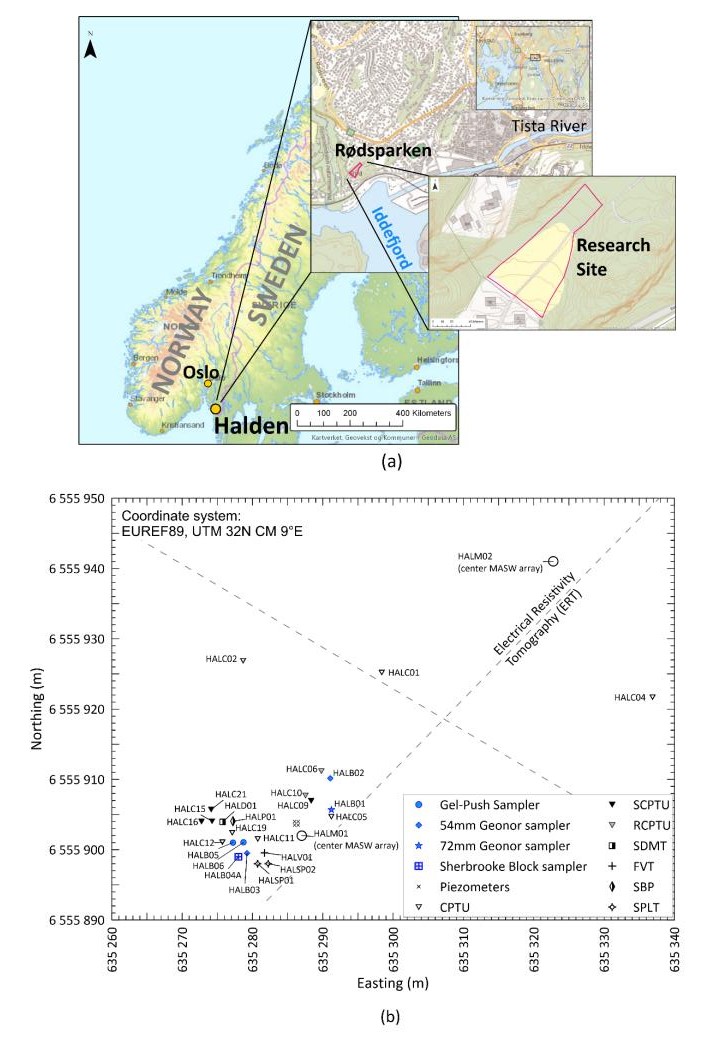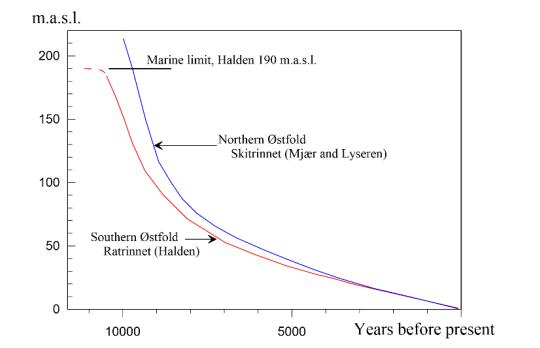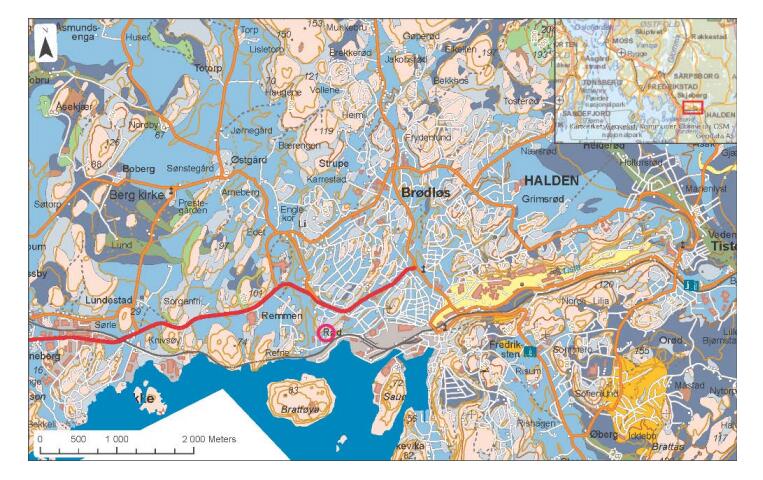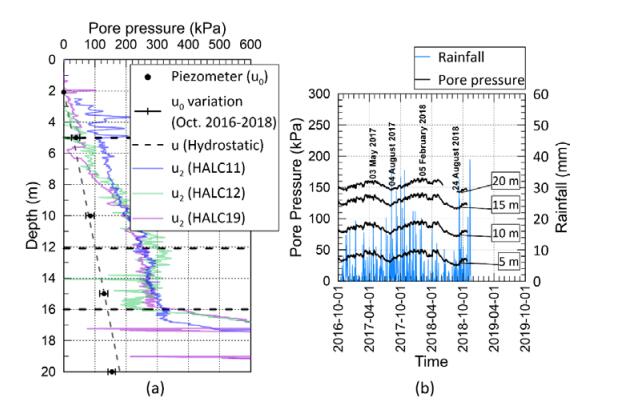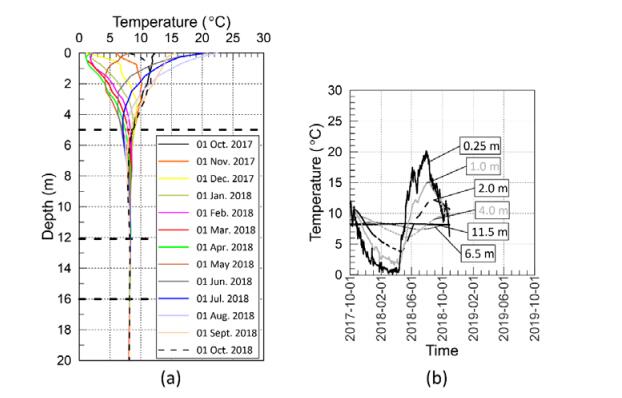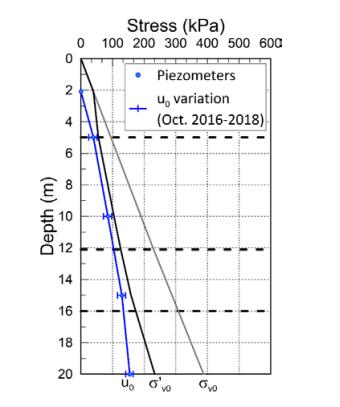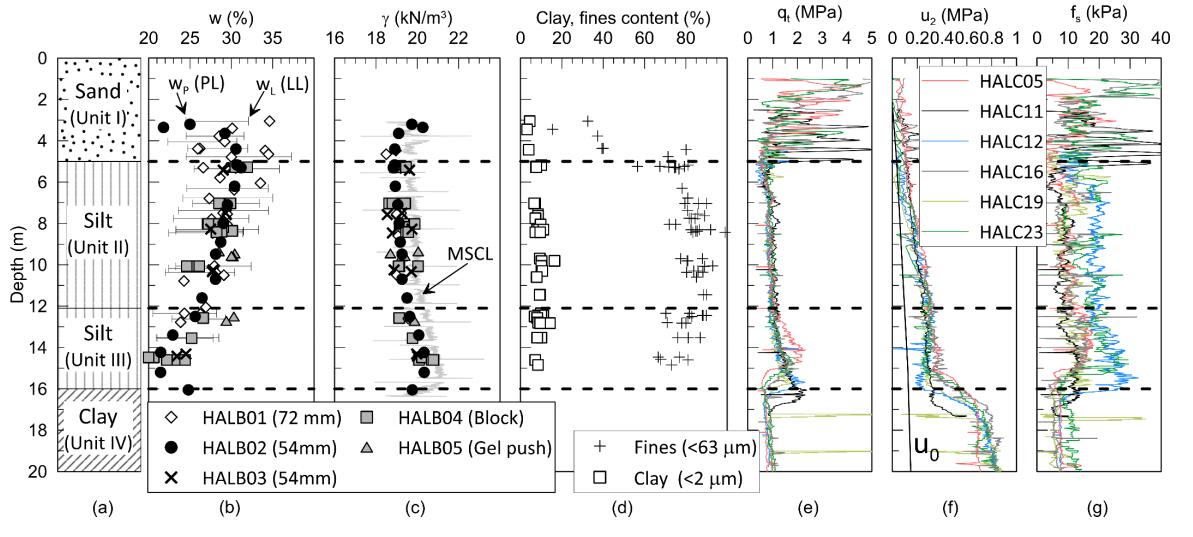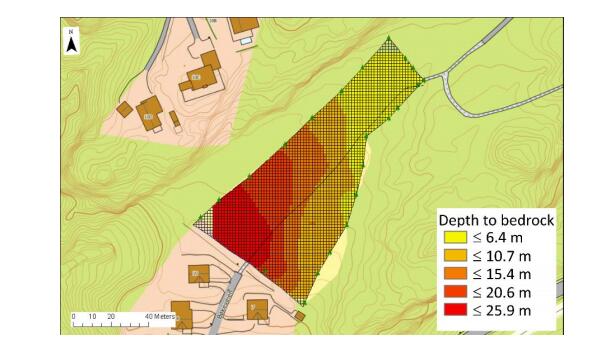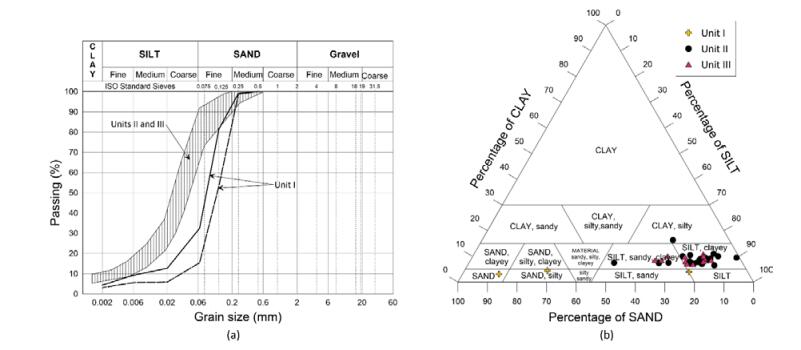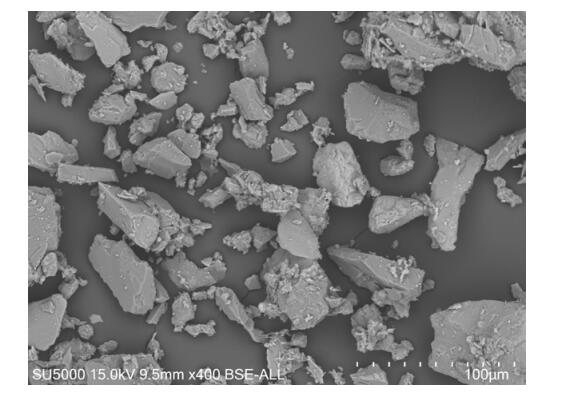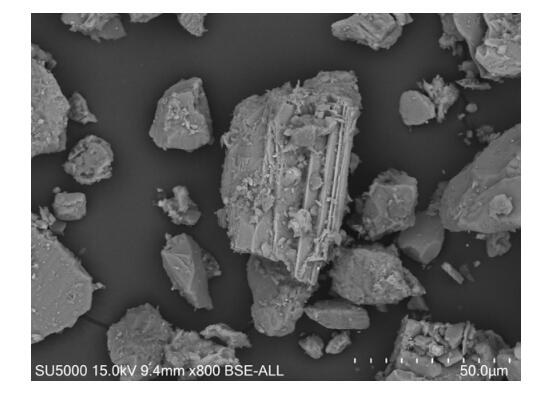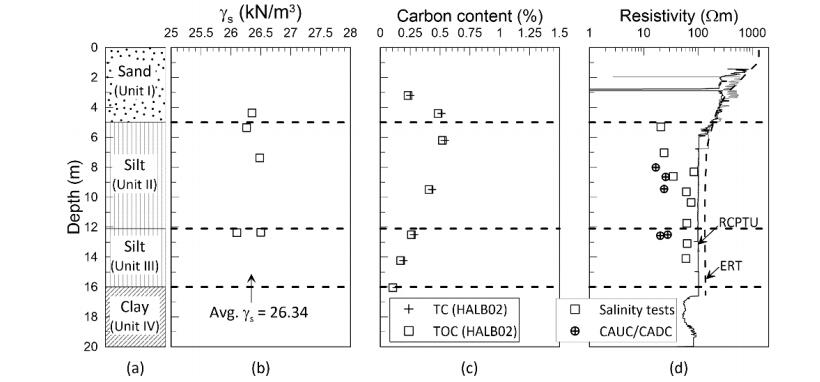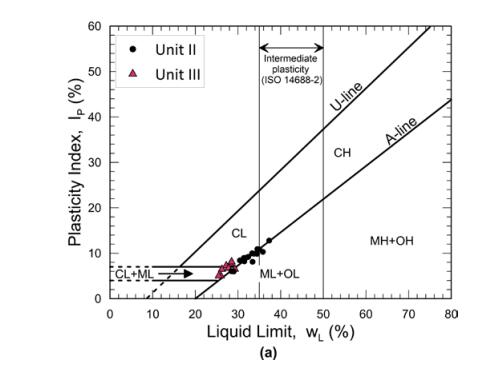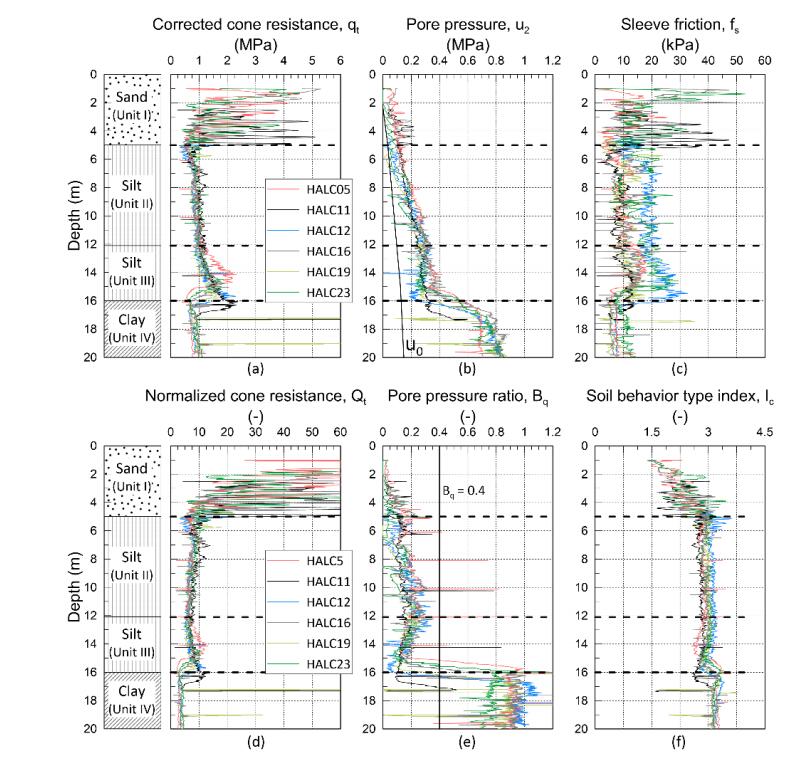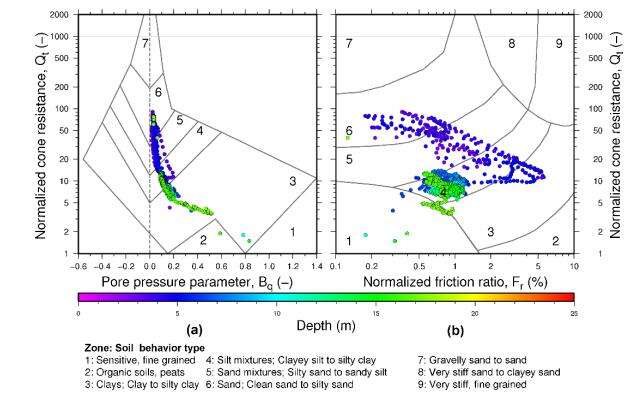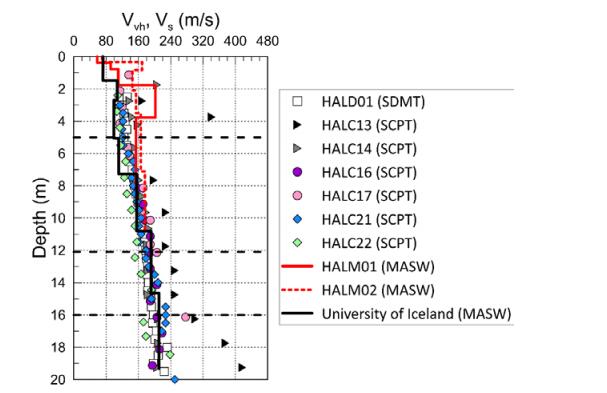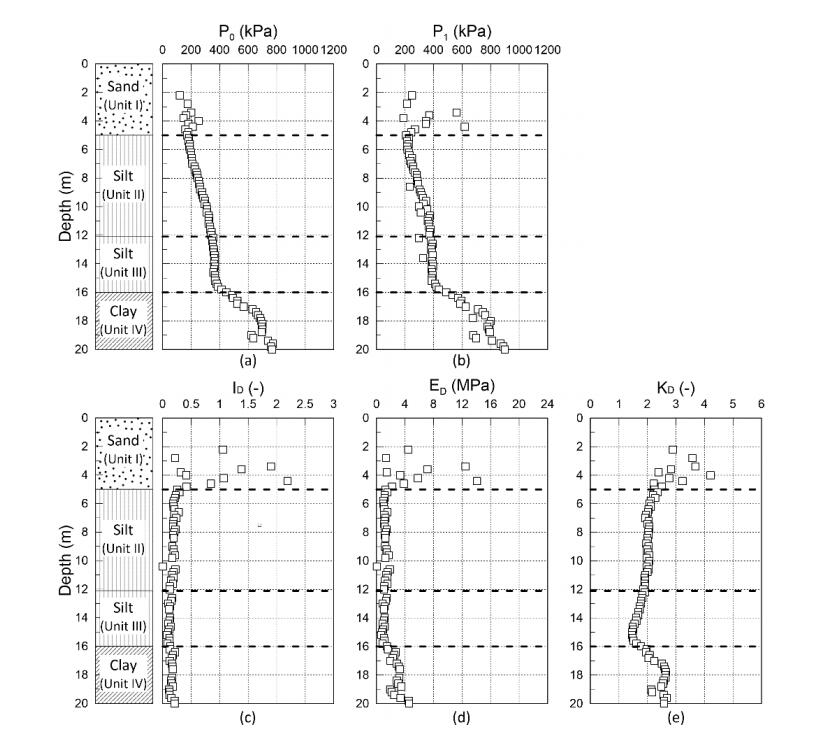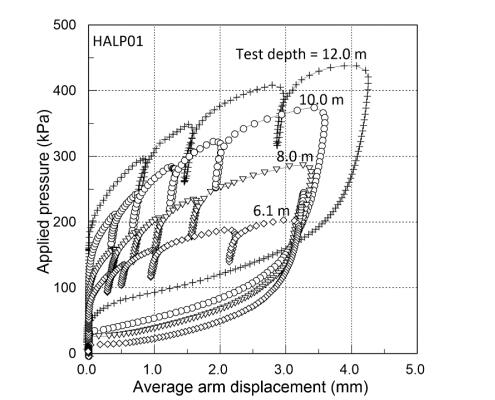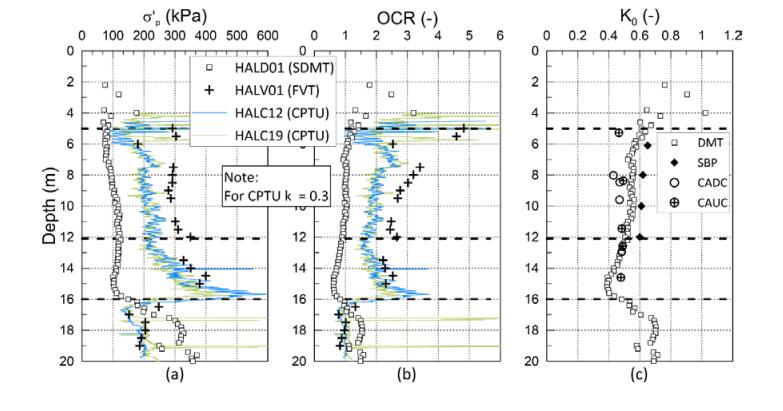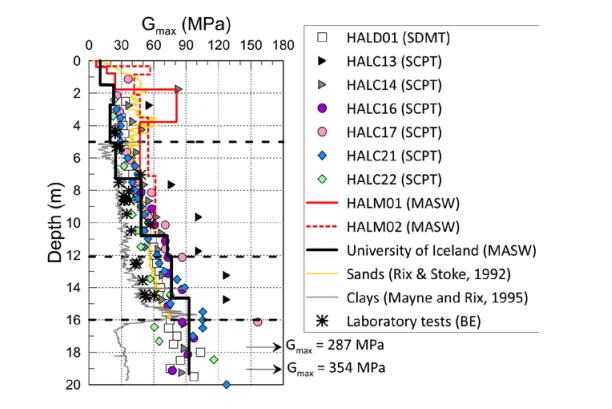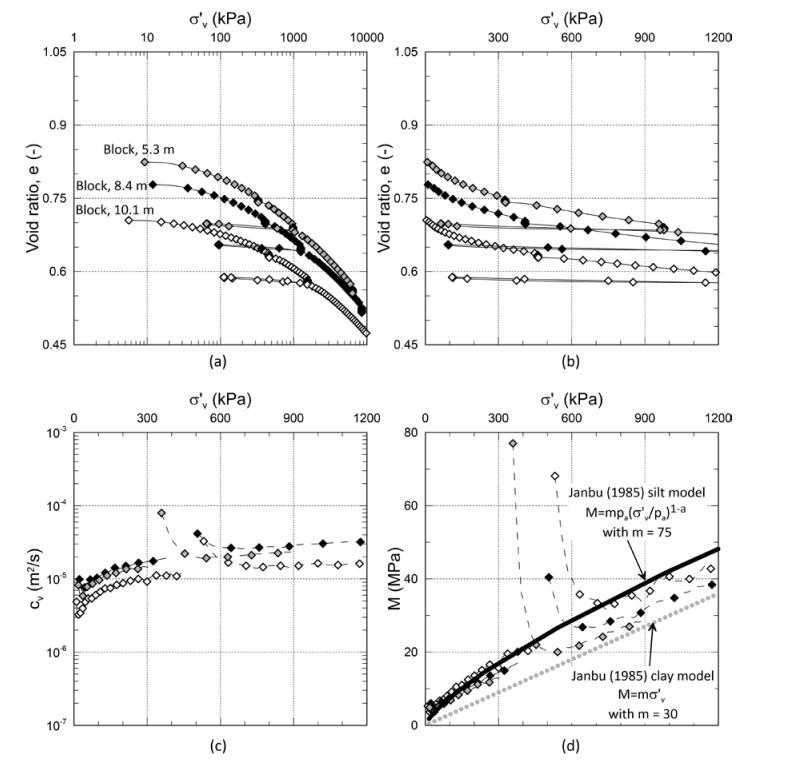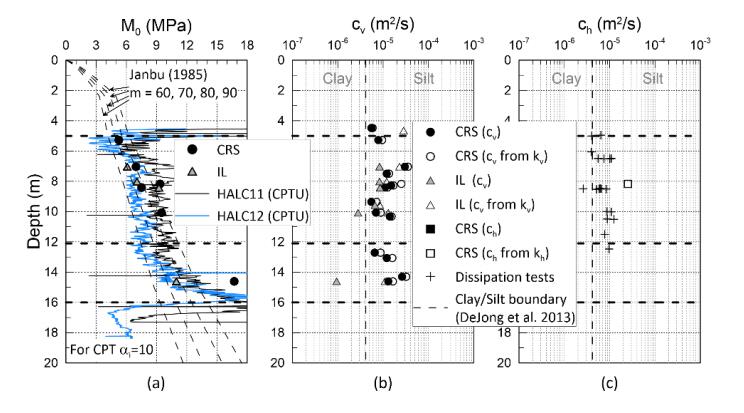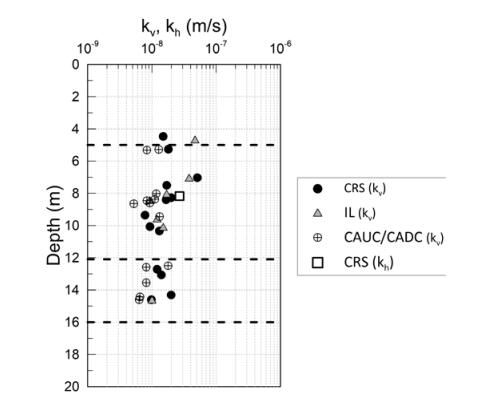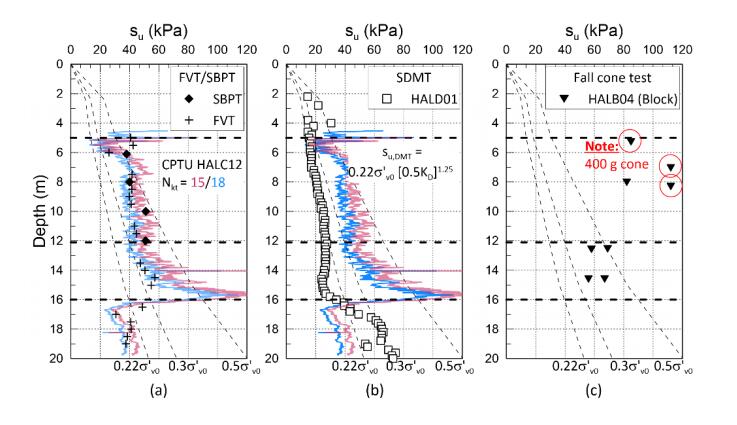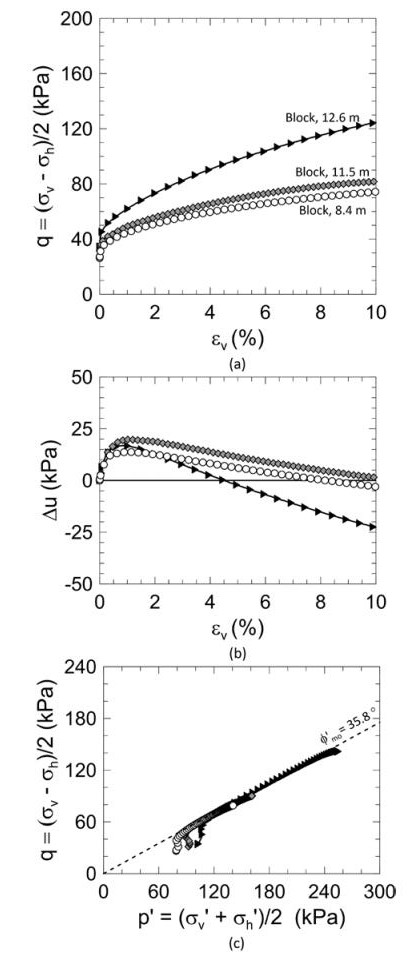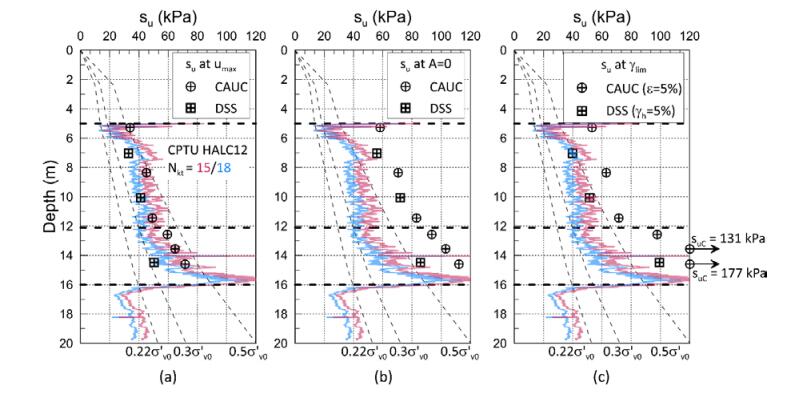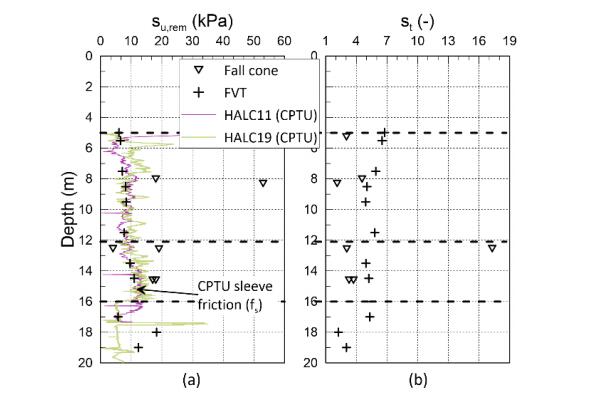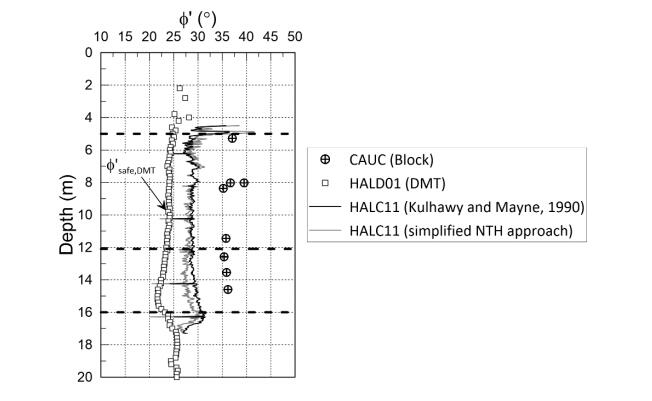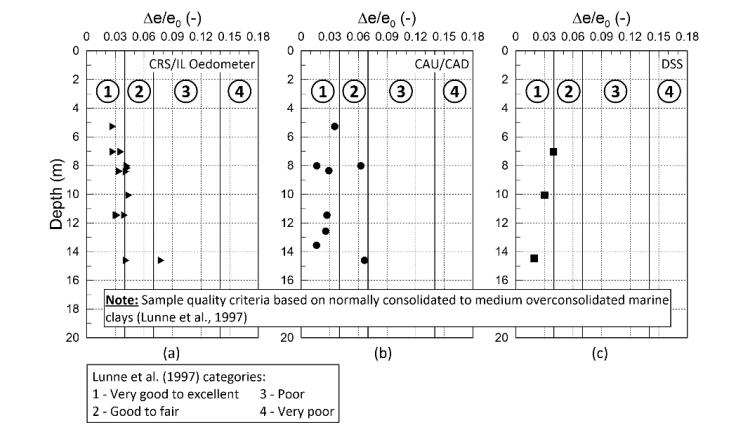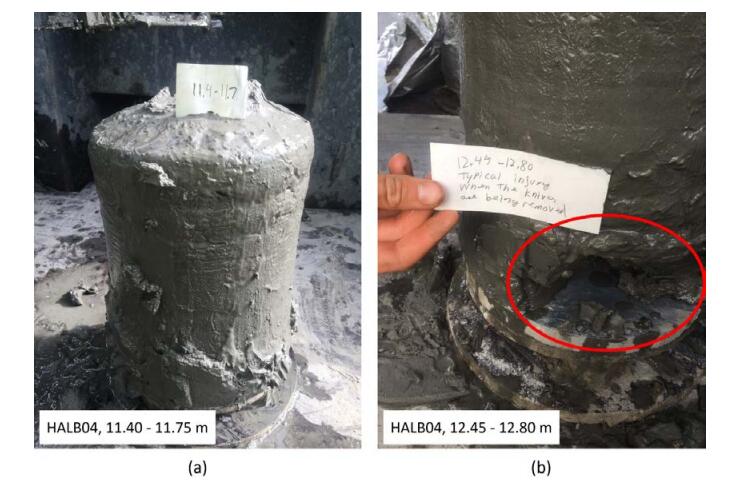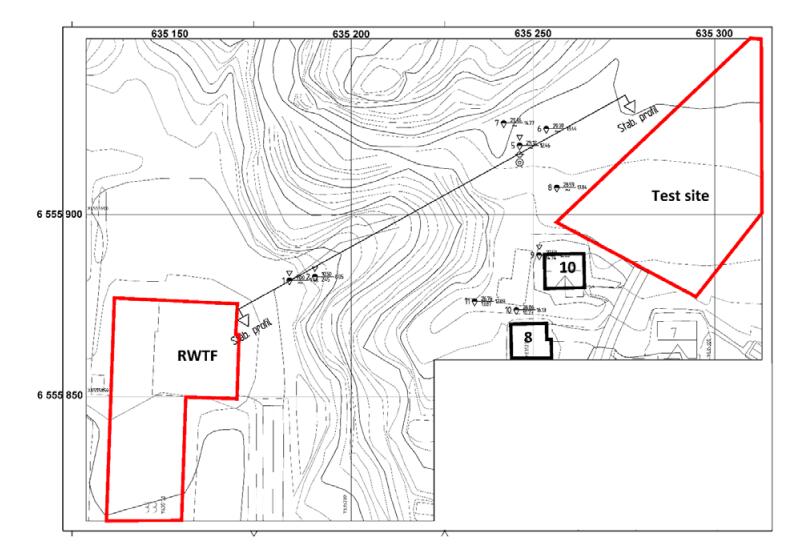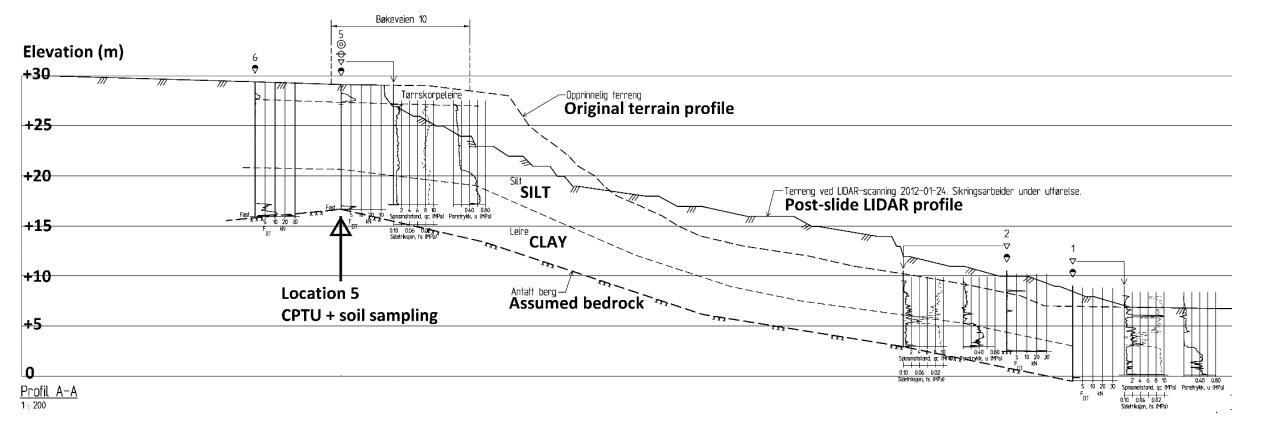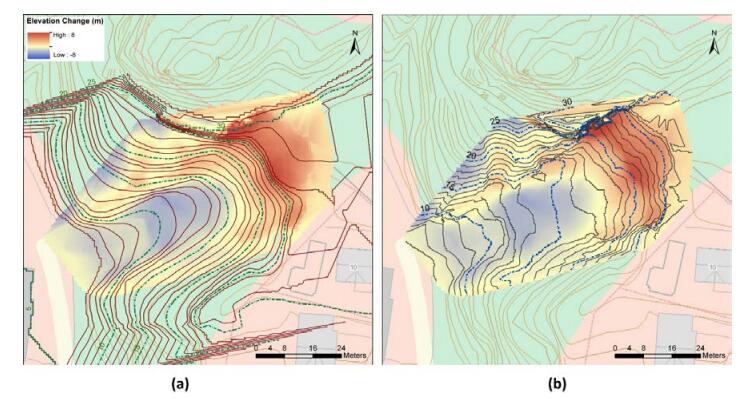This paper describes the geology and geotechnical engineering properties of the Halden silt; a 10–12 m thick deposit of fjord-marine, low plasticity clayey silt. Over the last six years, the test site has been well characterized by combining the results from a number of geophysical and in situ tools, including; electrical resistivity tomography, multi-channel analysis of surface wave surveys, cone penetration testing, dissipation testing, in situ pore pressure measurements, seismic flat dilatometer testing, field vane testing, self-boring pressure meter testing, screw plate load testing and hydraulic fracture testing. The results from these investigations assist the interpretation of layering and in situ soil properties. Soil sampling and advanced laboratory testing have provided data for interpretation of geological setting and depositional history, soil fabric, strength, stiffness and hydraulic properties. However, interpretation of the stress history, based on oedometer tests and clay-based correlations to the cone penetration test, are unreliable. They contradict the depositional history, which suggests that the soil units at the site are near normally consolidated, except for some surface weathering and desiccation. Further, undrained shear strength interpretations are complex as the in situ tests are potentially influenced by partial drainage, and conventional undrained triaxial tests do not provide a unique (peak) undrained shear strength. Despite certain interpretation challenges the paper presents important reference data to assist in the interpretation and assessment of similar silts, and provide some guidance on important geotechnical properties for projects where limited design parameters are available.
1.
Introduction
Group decision making (GDM), which needs some decision makers to select the best alternative, takes place widely in various fields of operations research and management science. Nowadays, due to the increasing complexity and fuzziness of the decision problems, it is almost impossible for a single expert to consider all the relevant aspects. Thus, GDM method becomes an interesting and important tool to solve many practical real-life problems. For the GDM problems, preference relations are good techniques to collect the wisdom of a group of decision makers, and pairwise comparison method is more accurate than non-pairwise comparison method [1]. Until now, many researchers have developed different kinds of preference relations, such as fuzzy preference relation (FPR) [2], multiplicative preference relation (MPR) [3], linguistic preference relation (LPR) [4], intuitionistic FPR (IFPR) [5], intuitionistic MPR (IMPR) [6], intuitionistic fuzzy LPR (IFLPR) [7], intuitionistic multiplicative LPR (IMLPR) [8], probabilistic LPR (PLPR) [9], hesitant FPR (HFPR) [10], hesitant fuzzy LPR (HFLPR) [11]. Moreover, various types of interval-valued preference relations have also been investigated. In the literature, many different GDM methods have been proposed by some researchers. Li et al. [12] solved a heterogeneous GDM problem with real values, intervals, triangular and trapezoidal fuzzy numbers based on the weighted-power average operator and TOPSIS method. By considering the preferred and non-preferred information simultaneously, Meng et al. [13] dealt with four preference relations under different intuitionistic environments. Li et al. [14] developed a GDM approach for supplier selection in view of multi-period fuzzy information and opinion interaction of decision makers. Meng et al. [15] proposed the linguistic intuitionistic fuzzy preference relation and applied it to multi-criteria GDM. Wu et al. [16] presented the eigenvector method and the corresponding adjustment method to address the site selection for earthquake shelters by using the hesitant multiplicative linguistic preference relation.
Generally speaking, the preference relations mainly defined on two term sets: the symmetric term set and the non-symmetric term set. The MPR, which uses Saaty's scale [1/9, 9] to measure the degree that one alternative is preferred to another, is one of the most important preference relations, but the elements in MPR are only characterized by a membership function which cannot describe the non-preferred information. Since intuitionistic fuzzy set can be used to depict the preference degree, the non-preference degree and the hesitancy degree jointly, and inspired by the IFPR [17], Xia et al. [6] put forward the IMPR, which defined on the intuitionistic multiplicative set (IMS). IMS uses an unbalanced, asymmetric scale to express the three different aspects of preference values and provide the comprehensive intuitive information. Thus, IMPR can deal with the unbalanced recognition for real-life decision making problems, one example is the law of diminishing marginal utility in economics. Sometimes, from the point of psychology, people are more sensitive to loss than gain, and in this situation, it needs to effectively reflect the asymmetrical and unbalanced views of decision makers. For this reason, the GDM with IMPRs has attracted increasing attentions in recent years.
When we try to rank the alternatives from the preference relations, a commonly used approach is the priority weights ranking method, which is divided into the agammaegation method and the modeling method [18]. The agammaegation method is using the agammaegation operators to fuse preference information in the preference relations. For the GDM with IMPRs, many intuitionistic multiplicative agammaegation operators have been investigated to fuse the preference information, such as intuitionistic multiplicative weighted averaging (IMWA) operator, intuitionistic multiplicative weighted geometric (IMWG) operator, intuitionistic multiplicative ordered weighted averaging (IMOWA) operator, intuitionistic multiplicative ordered weighted geometric (IMOWG) operator, generalized IMOWA (GIMOWA) operator, generalized IMOWG (GIMOWG) operator. For more details, one can refer to [6,19,20,21,22,23,24]. However, it is known that different ranking orders may be obtained with respect to different agammaegation operators, and there is no argument about which operator is better. Thus, in this paper, we mainly consider the modeling method to deal with GDM with IMPRs.
The modeling method is developed based on the consistency of preference relations and the consensus level among decision makers. In order to avoid illogical and contradictory ranking order, the consistency and consensus should be studied. Consistency is utilized to measure the degree of agreement among the preference values, while consensus is adopted to depict the degree of agreement among the decision makers [25]. Up to now, several different consistency concepts for IMPRs have been proposed [26,27,28,29,30,31]. Zhang and Pedrycz [31] revealed that the consistency of IMPRs in [29,30,31] satisfies the upper triangular property and the robust property. Thus, this concept is reasonable and can be taken as a good measurement for the consistency of IMPRs. In order to get the priority weight vector from an IMPR, some researchers [29,30,31,32,33] have established the relationship between an IMPR and a normalized intuitionistic fuzzy (multiplicative) weight vector. Li et al. [34] pointed out that these transformation formulas have some shortcomings and constructed a new transformation formula. Moreover, in a real GDM problem, it is almost impossible for the experts to give consistent IMPRs, especially when the number of objects is large, which means the consistency improving process should be considered. Until now, several different consistency indexes have been proposed to measure the acceptably consistent IMPRs, and some algorithms are also developed to improve the consistency of inconsistent IMPRs, readers can refer to [30,32,35,36,37]. Regrading to the consensus checking and improving process, there are also many achievements. Jiang et al. [38] studied some compatibility measures and gave two different consensus models to improve the group consensus level in GDM with IMPRs. Using a novel symmetric intuitionistic multiplicative agammaegation operator, Xu and Ma [39] provided a method for checking and reaching consensus. Zhang et al. [40] proposed an intuitionistic multiplicative GDM method based on a new outranking flow-based consensus measure.
Generally speaking, to solve a GDM problem with IMPRs, we should perform three processes [41]: (1) the consistency checking and repairing process of each IMPR; (2) the consensus checking and reaching process for the group; (3) the selection process. Sometimes, the consistency and consensus of a GDM with preference relations can be considered in two steps [42,43,44,45]. Firstly, a consistency index is introduced and a consistency control process is designed to repair an inconsistent preference relation to be of acceptable consistency. Secondly, the group consensus index is defined and one algorithm for reaching acceptable level of consensus is developed. Meanwhile, after reaching the consensus level, the modified preference relations should be still of acceptable consistency. As far as we know, only Meng et al. [28] and Zhang and Pedrycz [41] have developed a GDM method with IMPRs based on the consistency and consensus analysis. In Meng et al.'s method [28], it is very complex and complicated to judge the consistency and consensus of IMPRs. Meng et al. [28] employed the complete consistency analysis, and the complete consistency may take lots of time to reach and lose some information. Moreover, Meng et al. [28] calculated the geometric mean value of each row to fuse the preference information, which can not avoid the shortcomings in the agammaegation method. All in all, the computation cost in [28] is too large and the proposed method is not convenient to use. In Zhang and Pedrycz's method [41], they established one goal programming model to improve the consistency and consensus simultaneously. Compared with the two steps approach, the constraints in model (M-6) [41] are too strict, and the finally modified IMPRs may lose more information. Zhang and Pedrycz [41] used the expected proximity degree of all IMPRs to define a consensus index, it is quite complicated. When the group has acceptable consensus, we can not guarantee that the proximity degrees of all IMPRs are larger than a predefined threshold value. For the IMPRs, it is reasonable to use the intuitionistic multiplicative priority weight vector to reflect the importance of the alternatives, but Zhang and Pedrycz [41] only obtained the crisp priority weights. Thus, in order to circumvent the aforesaid drawbacks, we should do some other studies about GDM with IMPRs.
In this paper, we focus on the consistency and consensus of a GDM with IMPRs in two steps. Motivated by the acceptably multiplicative consistent IFPR [46], we first introduce the concept of acceptably consistent IMPR, then one automatic algorithm is developed to improve the consistency of an inconsistent IMPR. Meanwhile, the consensus index of each decision maker is defined and another algorithm for reaching acceptable level of consensus is proposed, which can guarantee that the consensus index of each expert is not smaller than a predefined threshold value. Moreover, the modified IMPRs in the consensus improving process still be acceptably consistent. Based on a mathematical programming model, the normalized intuitionistic multiplicative priority weight vector is generated from the fused group IMPR. Compared with the methods in [28,30,31,34,41], the advantages of the proposed approach are illustrated by two examples.
The rest of the paper is organized as follows. Section 2 reviews some basic knowledge related to the IMPRs. In Section 3, an automatic Algorithm I is designed to repair the inconsistent IMPR to be of acceptable consistency. Section 4 focuses on the consensus degree among the experts, and an Algorithm II is developed to help the group reach consensus. In Section 5, two examples are presented to show the validation and effectiveness of the proposed method, and the thorough comparative analyses are also conducted. Finally, Section 6 concludes the paper.
2.
Preliminaries
In this section, we review some basic knowledge related to the IMPRs.
Definition 2.1. ([6]) Let X be a fixed set, an IMS is defined as D={<x,ρD(x),σD(x)>∣x∈X}, which assigns to each element x a membership information ρD(x) and a non-membership information σD(x), with the conditions 1/9≤ρD(x),σD(x)≤9 and ρD(x)σD(x)≤1.
For convenience, Xia et al. [6] called (ρD(x),σD(x)) an intuitionistic multiplicative number (IMN) and denoted it by α=(ρα,σα), where 1/9≤ρα,σα≤9 and ρασα≤1. For an IMN α=(ρα,σα), Xia et al. [6] defined an accuracy function h(α)=ρασα, Jiang et al. [47] introduced a distance function p(α)=1−log9σα2−log9ρα−log9σα. Then, a method for ranking two IMNs α1=(ρα1,σα1) and α2=(ρα2,σα2) can be given as follows [47]:
If p(α1)>p(α2), then α1>α2.
If p(α1)=p(α2), and
if h(α1)>h(α2), then α1>α2;
if h(α1)=h(α2), then α1=α2.
Jiang et al. [47] have pointed out that their ranking method is more stable and less sensitive than the method in [6], and it can obtain a consistent result when little changes of the parameters of IMNs take place. Thus, in this paper, we use the above ranking method to compare IMNs.
By using IMNs to express pairwise judgments instead of exact numerical values in the MPR, Xia et al. [6] introduced the concept of IMPR.
Definition 2.2. ([6]) An IMPR on the alternative set X={x1,x2,⋯,xn} is defined as a matrix R=(αij)n×n=((ραij,σαij))n×n, where ραij,σαij∈[1/9,9], ραijσαij≤1, ραij=σαji, σαij=ραji, ραii=σαii=1, and ραij indicates the degree to which the object xi is preferred to the object xj, σαij means the degree to which the object xi is not preferred to the object xj.
For convenience, IMN αij=(ραij,σαij) can be denoted as αij=(ρij,σij).
Definition 2.3. ([48]) Let Rk=(αkij)n×n with αkij=(ρkij,σkij) (k=1,2) be two IMPRs, then the distance measure between them comes as
In order to obtain a logical conclusion from preference relations, consistency is a basic property which should be considered, and one reasonable concept for the consistency of IMPRs is given as follows.
Definition 2.4. ([29,30,31]) An IMPR R=(αij)n×n with αij=(ρij,σij) is called consistent if the following transitivity is satisfied:
Note that the equations used to define the consistency of IMPRs in [29,30,31] are equivalent to Eq. (2.2).
Theorem 2.1. ([30,31]) Let R=(αij)n×n be an IMPR with αij=(ρij,σij), then the following two statements are equivalent:
Suppose ω=(ω1,ω2,⋯,ωn)T be the underlying intuitionistic multiplicative priority weight vector of an IMPR R=(αij)n×n, where ωi=(ωρi,ωσi) (i=1,2,⋯,n) is an IMN, which satisfies ωρi,ωσi∈[1/9,9] and ωρiωσi≤1. ωρi and ωσi indicate the membership and non-membership degrees of the alternative xi as per a fuzzy concept of "importance", respectively. The normalization of ω can be done via the following definition.
Definition 2.5. ([29,30,32]) An intuitionistic multiplicative weight vector ω=(ω1,ω2,⋯,ωn)T with ωi=(ωρi,ωσi), ωρi,ωσi∈[1/9,9] and ωρiωσi≤1 is said to be normalized if it satisfies the following conditions:
The relationship between an IMPR and a normalized intuitionistic multiplicative weight vector have been studied by some researchers [29,30,32], Li et al. [34] analyzed the shortcomings of these formulas and proposed a new transformation formula.
Theorem 2.2. ([34]) Let ω=(ω1,ω2,⋯,ωn)T = ((ωρ1,ωσ1),(ωρ2,ωσ2),⋯,(ωρn,ωσn))T be a normalized intuitionistic multiplicative weight vector with ωρi,ωσi∈[1/9,9], ωρiωσi≤1, ∏nj=1,j≠iωρj≤ωσi and ωρi≥∏nj=1,j≠iωσj, for all i=1,2,⋯,n, then the preference relation P=(pij)n×n is a consistent IMPR, where
Corollary 2.1. For an IMPR R=(αij)n×n with αij=(ρij,σij), if there exists a normalized intuitionistic multiplicative weight vector ω=(ω1,ω2,⋯,ωn)T=((ωρ1,ωσ1),(ωρ2,ωσ2),⋯,(ωρn,ωσn))T, such that
then R=(αij)n×n is a consistent IMPR.
In a decision making process, for the purpose of getting a reasonable result, the IMPR R=(αij)n×n provided by the decision maker should be consistent. However, in most decision making problems, it is hard for a decision maker to build such a consistent IMPR, then it is expected that the deviation between the given IMPR and its corresponding underlying consistent IMPR should be as small as possible. Using the relationship between an IMN and the associated intuitionistic fuzzy number (IFN) given by Jiang et al. [47], and motivated by the programming model in [49], Li et al. [34] established the following Model 1 to get the normalized intuitionistic multiplicative weight vector ω=(ω1,ω2,⋯,ωn)T from an IMPR R=(αij)n×n=((ρij,σij))n×n.
In order to use the Model 1 in a more convenient way, we can modify it into a similar Model 2, where ε+ij=|εij|+εij2, ε−ij=|εij|−εij2, η+ij=|ηij|+ηij2, η−ij=|ηij|−ηij2, and εij=log9ρij−0.5log9ωρi−0.5log9ωσj, ηij=log9σij−0.5log9ωσi−0.5log9ωρj.
It is obvious that the optimal normalized intuitionistic multiplicative priority weights obtained from the Model 1 and Model 2 are same. We can verify that ωρi=ωσi=1, ωρj=ωσj=1, ε+ij=|log9ρij|+log9ρij2, ε−ij=|log9ρij|−log9ρij2, η+ij=|log9σij|+log9σij2 and η−ij=|log9σij|−log9σij2 satisfy the constraints in the Model 2, i.e., the feasible set of Model 2 is non-empty. Thus, the Model 2 always has a solution. Using some optimization computer packages to solve the Model 2 (such as Lingo or Matlab), we can derive the optimal objective function value J∗ and the normalized intuitionistic multiplicative priority weight vector ω∗=(ω∗1,ω∗2,⋯,ω∗n)T=((ωρ∗1,ωσ∗1),(ωρ∗2,ωσ∗2),⋯,(ωρ∗n,ωσ∗n))T.
Remark 2.1. From Theorem 2.2, a consistent IMPR P∗=(p∗ij)n×n can be constructed by the optimal normalized intuitionistic multiplicative priority weight vector ω∗=(ω∗1,ω∗2,⋯,ω∗n)T, where
Moreover, the optimal objective function value J∗ in the Model 2 can be easily expressed as
According to Definition 2.3, the optimal objective function value J∗ is actually the distance measure between the given IMPR R=(αij)n×n and the corresponding underlying consistent IMPR P∗=(p∗ij)n×n, i.e., J∗=d(R,P∗).
3.
Acceptable consistency of intuitionistic multiplicative preference relations
When we solve the Model 2, if the optimal objective function value J∗=0, from Remark 2.1, we can easily get ρij=√ωρ∗iωσ∗j, σij=√ωσ∗iωρ∗j, i,j=1,2,⋯,n,i≠j. According to Corollary 2.1, IMPR R=(αij)n×n is consistent, and the derived normalized intuitionistic multiplicative priority weight vector is reasonable. If J∗≠0, which means R=(αij)n×n is inconsistent, although the underlying intuitionistic multiplicative weight vector can still be obtained, we should not forget that inconsistent IMPR may generate unreasonable result. In such situation, a better way is to return the inconsistent IMPR to decision maker to revaluate and give new IMPR until the consistency is reached or accepted. However, in some cases, we cannot find the initial expert (or the expert is not willing) to modify his/her preference values, so an automatic method should be developed to improve the consistency of inconsistent IMPRs.
From Model 2, we can always derive the optimal objective function value J∗ and the corresponding normalized intuitionistic multiplicative priority weight vector ω∗=(ω∗1,ω∗2,⋯,ω∗n)T, then a underlying consistent IMPR P∗=(p∗ij)n×n with p∗ij=(pρ∗ij,pσ∗ij) can be constructed from Eq. (2.3). Motivated by the Definition 7 given in Liao and Xu [46], we introduce the following concept of acceptably consistent IMPR.
Definition 3.1. Let R=(αij)n×n be an IMPR with αij=(ρij,σij), then we call R an acceptably consistent IMPR, if
where ξ is the consistency threshold and d(R,P∗) is the distance measure between the given IMPR R and its corresponding underlying consistent IMPR P∗.
Note that from Remark 2.1, the distance measure d(R,P∗) can also be calculated by
Remark 3.1. Considering the definition of an acceptably consistent IMPR given by Zhang and Guo [30], these two definitions are similar but our definition is more reasonable. Zhang and Guo [30] also used the distance measure d(R,R∗) to define the acceptable consistency, where the consistent IMPR R∗ only has the smallest distance from R. However, in our Definition 3.1, except the smallest distance, the consistent IMPR P∗ is actually constructed by the normalized intuitionistic multiplicative priority weights of R. Thus, compared with the consistent IMPR R∗ in [30], the corresponding underlying consistent IMPR P∗ we use can provide more information. At the end of this section, an example is presented to illustrate this remark.
In a practical decision making problem, the consistency threshold ξ can be given in advance, different values reflect different preference of the decision makers, but there is no theoretical methodology to determine such a value. Motivated by the work of Zhang and Guo [30], we propose the following automatic algorithm to improve the consistency of an unacceptably consistent IMPR.
Algorithm I.
Input: An IMPR R=(αij)n×n with αij=(ρij,σij), the consistency threshold ξ and the adjustment parameter θ∈(0,1).
Output: An acceptably consistent IMPR ¯R and the distance measure ¯J∗.
Step 1: Let h=0 and R(0)=R.
Step 2: Solve Model 2 for R(h) to obtain the optimal objective function value J(h)∗ and the normalized intuitionistic multiplicative priority weight vector ω(h)∗=(ω(h)∗1,ω(h)∗2,⋯,ω(h)∗n)T. If distance measure J(h)∗≤ξ, go to Step 4. Otherwise, build a consistent IMPR P(h)∗=(p(h)∗ij)n×n with p(h)∗ij=(p(h)ρ∗ij,p(h)σ∗ij) according to Eq (2.3), go to Step 3.
Step 3: Build a new IMPR R(h+1)=(α(h+1)ij)n×n with α(h+1)ij=(ρ(h+1)ij,σ(h+1)ij), where
Let h=h+1, go to Step 2.
Step 4: Let ¯R=R(h) and ¯J∗=J(h)∗, then output ¯R and ¯J∗.
Theorem 3.1. The automatic Algorithm I is convergent.
Proof. When we solve the Model 2 for R(h+1) to obtain the optimal objective function value J(h+1)∗, and note that the normalized intuitionistic multiplicative priority weight vector ω(h)∗=(ω(h)∗1,ω(h)∗2,⋯,ω(h)∗n)T of R(h) is a feasible solution, then from Eq (3.2), we can have
Thus, we can easily get J(h+1)∗≤(1−θ)h+1J(0)∗, which means limh→∞J(h+1)∗=0, and the proof of Theorem 3.1 is completed.
From Theorem 3.1, we can see that for any consistency threshold ξ∈(0,1), we can always find an IMPR ¯R by Algorithm I, such that ¯R is an acceptably consistent IMPR.
Remark 3.2. In the Algorithm I, if the maximum iteration number is assumed to be H, we can adjust the iterative formula Eq (3.3) to be
The above iteration process is also convergent, and this proof is similar to the proof of Theorem 1 in [44], which is omitted here. In this paper, we use Algorithm I to repair the inconsistent IMPR to be of acceptable consistency.
Definition 3.2. Let Rl=(αlij)n×n with αlij=(ρlij,σlij) be an IMPR given by the decision maker dl (l=1,2,⋯,m), and λ={λ1,λ2,⋯,λm}T be the weight vector of the decision makers, such that λl>0 and ∑ml=1λl=1, then Rc=(αcij)n×n with αcij=(ρcij,σcij)=(∏ml=1(ρlij)λl,∏ml=1(σlij)λl) is called a group IMPR.
Xu [26] have showed that Rc is still an IMPR, Zhang and Guo [30] proved that if all individual IMPRs Rl (l=1,2,⋯,m) are consistent, then the group IMPR Rc is also consistent. In fact, under our definition of acceptable consistency, the following theorem can also be obtained which is similar to the Theorem 8 in [30].
Theorem 3.2. If all individual IMPRs Rl=(αlij)n×n given by the decision makers are acceptably consistent, then the group IMPR Rc=(αcij)n×n is also acceptably consistent.
Proof. Since each individual Rl is an acceptably consistent IMPR, from Eqs (3.1) and (3.2), we have
where ωl∗=(ωl∗1,ωl∗2,⋯,ωl∗n)T with ωl∗i=(ωl,ρ∗i,ωl,σ∗i) is the normalized intuitionistic multiplicative priority weight vector of Rl and the consistent IMPR Pl∗=(pl∗ij)n×n=((pl,ρ∗ij,pl,σ∗ij))n×n is constructed by the Eq (2.3).
Let υρi=∏ml=1(ωl,ρ∗i)λl and υσi=∏ml=1(ωl,σ∗i)λl (i=1,2,⋯,n), we can easily get υρi,υσi∈[1/9,9] and υρiυσi≤1, i.e., (υρi,υσi) is an IMN. Moreover,
Similarly, we can also have υρi≥∏nj=1,j≠iυσj. Thus, υ=(υ1,υ2,⋯,υn)T with υi=(υρi,υσi) is a normalized intuitionistic multiplicative vector, which means υ is a feasible solution for the corresponding Model 2, then we can obtain
According to the Definition 3.1, the group IMPR Rc is acceptably consistent.
In the following, we use an example to illustrate how to check and improve the consistency of an IMPR.
Example 3.1. ([30]) Let X={x1,x2,x3,x4} be the set of four alternatives, and an IMPR is provided by a decision maker as
By solving the models (M-2) and (M-3) in [30], the consistency index of A is calculated as 0.0866>ξ=0.08, and the consistent IMPR is derived as
Using the Eq (13) in [30], an acceptably consistent IMPR ¯A1 is given by
If we insert IMPR A into our Model 2, we can get the following Model 3.
Using the Lingo software, we can find that the optimal objective function value is also given by J∗=0.0866, and the normalized intuitionistic multiplicative priority weight vector is derived as
Then, from Remark 2.1, we can construct a consistent IMPR A∗2,
Clearly, A∗1 and A∗2 are not the same, but we can easily check that d(A,A∗1)=d(A,A∗2)=0.0866. Zhang and Guo [30] have showed that there may be more than one consistent IMPR which has the smallest distance from the original judgment A, and we can see that the consistent IMPRs A∗1 and A∗2 both have the smallest distance. As we have explained in the Remark 3.1, the consistent IMPR A∗2 can give us more information than A∗1, because A∗2 is actually established by the normalized intuitionistic multiplicative priority weights of A. Therefore, compared with the method in Zhang and Guo [30], it is more reasonable to use our consistent IMPR A∗2 to improve the consistency of A. Let the adjustment parameter θ in the Algorithm I be 0.4, then an acceptably consistent IMPR ¯A2 can be generated as
In fact, taking ¯A2 into the Model 2, we can get the optimal objective function value J∗=0.0519<ξ=0.08, which means the IMPR ¯A2 is of acceptable consistency.
4.
Consensus for group decision making with intuitionistic multiplicative preference relations
Consider a GDM in which X={x1,x2,⋯,xn} is the set of alternatives, D={d1,d2,⋯,dm} is the set of decision makers, and λ={λ1,λ2,⋯,λm}T is the weight vector of experts, such that λl>0 and ∑ml=1λl=1. The decision maker dl can give an IMPR Rl=(αlij)n×n by making pairwise comparisons for all alternatives, where αlij=(ρlij,σlij) is the preference information in IMN. If the individual IMPR Rl (l=1,2,⋯,m) is not acceptably consistent, we should first use Algorithm I to improve the consistency of Rl to be acceptable. Without loss of generality, all the individual IMPRs considered in this section are acceptably consistent, which are still denoted as Rl.
For each acceptably consistent IMPR Rl, the corresponding normalized intuitionistic multiplicative priority weight vector ωl∗ can be obtained via Model 2, then the ranking order of the alternatives will be derived by the comparison law for IMNs in Section 2. However, different decision makers would produce different ranking orders, it is difficult to get a solution which is agreed by all experts. Thus, it is very important for the decision makers to find an acceptable solution, and consensus is a good pathway which guarantees that the final result is supported by all experts despite their different opinions [50,51,52]. In order to reach consensus, the first thing we should do is to measure the consensus degree among the decision makers whose opinions are represented by IMPRs.
Definition 4.1. For a set of IMPRs Rl=(αlij)n×n with αlij=(ρlij,σlij) given by the decision maker dl (l=1,2,⋯,m), and λ={λ1,λ2,⋯,λm}T is the weight vector of the decision makers, then the consensus index of the lth expert dl is defined by
where Rc=(αcij)n×n=((ρcij,σcij))n×n is a group IMPR with ρcij=∏ml=1(ρlij)λl, σcij=∏ml=1(σlij)λl.
In fact, the consensus above can be explained as closeness between the individual opinion and the group opinion. If C(Rl) = 1, then the lth decision maker has full consensus with the group. Clearly, the bigger the value of C(Rl), the closer the decision maker is to the group. For a practical GDM problem, decision makers can determine a minimum consensus degree ζ in advance to measure the deviation between the individual preference relation and the group preference relation. If C(Rl)≥ζ holds for all decision makers dl (l=1,2,⋯,m), then an acceptable level of consensus is achieved, i.e., the group reaches consensus. Inspired by the iterative model in Chu et al. [45], we give the following automatic algorithm to help decision makers reach consensus.
Algorithm II.
Input: The weight vector λ={λ1,λ2,⋯,λm}T, the IMPRs Rl=(αlij)n×n with αlij=(ρlij,σlij) (l=1,2,⋯,m), the maximum number of iterations hmax and the predefined consensus degree ζ.
Output: Modified IMPRs ˜Rl and the consensus index C(˜Rl).
Step 1: Let h=0 and Rl(0)=(αl(0)ij)n×n with αl(0)ij=(ρl(0)ij,σl(0)ij)=(ρlij,σlij) (l=1,2,⋯,m).
Step 2: Fuse the individual preference relations Rl(h) into a group IMPR Rc(h)=(αc(h)ij)n×n=((ρc(h)ij,σc(h)ij))n×n, where ρc(h)ij=∏ml=1(ρl(h)ij)λl, σc(h)ij=∏ml=1(σl(h)ij)λl.
Step 3: Calculate the consensus index C(Rl(h)) by Eq. (4.1). If C(Rl(h))≥ζ for all l=1,2,⋯,m or h≥hmax, go to Step 5. Otherwise, continue with the next step.
Step 4: Suppose that C(Rτ(h))=minl{C(Rl(h))}, and construct some IMPRs Rl(h+1)=(αl(h+1)ij)n×n=((ρl(h+1)ij,σl(h+1)ij))n×n, where
with βh∈(0,1−maxl≠τ{d(Rl(h),Rc(h))d(Rτ(h),Rc(h))}].
Set h=h+1, go to Step 2.
Step 5: Let ˜Rl=Rl(h) and C(˜Rl)=C(Rl(h)) (l=1,2,⋯,m), then output ˜Rl and C(˜Rl).
Theorem 4.1. Suppose Rl(h) be the IMPR in the (h)th iteration by Algorithm II. If minl{C(Rl(h))}<ζ, then minl{C(Rl(h+1))}>minl{C(Rl(h))}.
Proof. Assume the decision maker dk has the smallest consensus level in the hth iteration, which means C(Rk(h))=minl{C(Rl(h))}. According to the Algorithm II, the IMPR Rk(h) should be modified in the (h+1)th iteration based on Eq (4.2), and we can have
Similarly, we can also get
In the following, we consider two cases.
Case 1: l=k.
Using Eqs (4.3) and (4.4), it follows that
Consequently,
which means
Case 2: l≠k.
Obviously, d(Rl(h),Rc(h))<d(Rk(h),Rc(h)) holds. Since βh∈(0,1−maxl≠k{d(Rl(h),Rc(h))d(Rk(h),Rc(h))}], we have d(Rl(h),Rc(h))≤(1−βh)d(Rk(h),Rc(h)) for all l≠k. Thus, from Eqs (4.3) and (4.4), we get
Thus, for l≠k,
which means
We summarize the above two cases, from Eqs (4.5) and (4.6), it is obvious that minl{C(Rl(h+1))}>minl{C(Rl(h))}.
Theorem 4.1 shows that the modified IMPR has a better consensus level, and the minimum consensus index after implementing Algorithm II is better than the last one. In each iteration, the adjustment parameter βh is further restricted, the reason is that this restricted condition can theoretically guarantee the minimum consensus index is increasing during the group consensus improving process. Generally speaking, for a practical decision making problem, after implementing the process finite times, the group can achieve a predefined consensus level even for βh∈(0,1), but in this case, the minimum consensus index may not always be increasing. Moreover, according to Theorem 3.2, we know that the modified IMPR ˜Rl in Algorithm II is also acceptably consistent. Now we can obtain the group IMPR ˜RC according to Definition 3.2, and solve Model 2 for ˜RC to generate the optimal normalized intuitionistic multiplicative priority weight vector ω∗=(ω∗1,ω∗2,⋯,ω∗n)T. Finally, the ranking order of the alternatives can be derived via the comparison law for IMNs in Section 2.
For the convenience of application, the concrete steps of the proposed method for GDM with IMPRs are described in the following.
Step 1. Decision makers construct some IMPRs Rl (l=1,2,⋯,m) by making pairwise comparisons for all alternatives.
Step 2. Solve Model 2 for each Rl to obtain the optimal objective function value Jl∗ and the normalized intuitionistic multiplicative priority weight vector ωl∗.
Step 3. Check the consistency of each IMPR Rl by using Definition 3.1. If all of the IMPRs are of acceptable consistency, let ¯Rl=Rl, go to Step 5; Otherwise, go to Step 4.
Step 4. Repair the inconsistent IMPRs Rl (l=1,2,⋯,m) to be ¯Rl with acceptable consistency according to Algorithm I.
Step 5. Calculate the consensus index C(¯Rl) for each IMPR ¯Rl according to Eq. (4.1), if the group reaches consensus, let ˜Rl=¯Rl, go to Step 7; Otherwise, go to Step 6.
Step 6. Using the iteration Algorithm II to improve the group consensus level and get the modified IMPRs ˜Rl (l=1,2,⋯,m).
Step 7. Fuse the IMPRs ˜Rl (l=1,2,⋯,m) into a group IMPR ˜RC according to Definition 3.2.
Step 8. Solve Model 2 for ˜RC to generate the optimal normalized intuitionistic multiplicative priority weight vector ω∗=(ω∗1,ω∗2,⋯,ω∗n)T.
Step 9. Compare the intuitionistic multiplicative priority weights ω∗1,ω∗2,⋯,ω∗n to derive the ranking order of the alternatives.
5.
Numerical example and comparative analysis
In this section, two numerical examples and the corresponding comparison analyses are presented to illustrate the effectiveness and superiority of the proposed method.
Example 5.1. ([26,30,31]) Four university students want to install broadband Internet connection, and there are four available options, which are provided by three Internet-service providers 1) x1: 1 Mb/s broadband; 2) x2: 2 Mb/s broadband; 3) x3: 3 Mb/s broadband; 4) x4: 8 Mb/s broadband. The Internet service and its monthly bill will be shared among the four students dk (k=1,2,3,4) (whose weight vector is λ=(0.3,0.3,0.2,0.2)T), and they decide to perform a group decision analysis. The four students construct the following IMPRs Rk (k=1,2,3,4) to reveal their preference relations for the options independently.
Taking R1, R2, R3 and R4 into the Model 2, respectively, and we can have
Without loss of generality, let the consistency threshold ξ be 0.08, then J1∗>ξ and J4∗>ξ, which means IMPRs R1 and R4 need to be adjusted. Let the adjustment parameter θ be 0.4, using Algorithm I, we obtain two adjusted IMPRs ¯R1 and ¯R4.
Taking ¯R1 and ¯R4 into the Model 2, we can get ¯J1∗=0.0591<ξ and ¯J4∗=0.0545<ξ. Thus, four acceptably consistent IMPRs ¯R1, ¯R2=R2, ¯R3=R3 and ¯R4 are derived, and the group IMPR ¯Rc is given by
Then, according to Eq (4.1), we have C(¯R1)=0.9382, C(¯R2)=0.9410, C(¯R3)=0.8803 and C(¯R4)=0.9599. Let the consensus degree ζ be 0.92, which means the group consensus is not reached, and the IMPR ¯R3 need to be modified.
Using Algorithm II, from Table 1, we can see that the group consensus is reached after 5 steps. Moreover, it is obvious that min1≤l≤4{C(Rl(h+1))}>min1≤l≤4{C(Rl(h))} for each 0≤h≤4, which verifies the conclusion of Theorem 4.1. When the Algorithm II is terminated, four IMPRs ˜R1, ˜R2, ˜R3 and ˜R4 are obtained, where ˜R1=¯R1, ˜R2=¯R2=R2, ˜R4=¯R4 and ˜R3 is given by
According to Theorem 3.2, the IMPR ˜R3 is still acceptably consistent. In fact, utilizing Model 2 to solve ˜R3, we will find ˜J3∗=0.0409<ξ. Now, from ˜R1, ˜R2, ˜R3 and ˜R4, we can get a group IMPR ˜Rc,
Using Model 2 to generate the optimal normalized intuitionistic multiplicative priority weight vector ω∗, which is given by
Calculate the distance functions of the intuitionistic multiplicative priority weights ω∗1, ω∗2, ω∗3 and ω∗4, we can obtain p(ω∗1)=0.3996, p(ω∗2)=0.1779, p(ω∗3)=0.6706 and p(ω∗4)=0.6381. Then from the ranking method in Section 2, we have ω∗3>ω∗4>ω∗1>ω∗2, which means the four options can be ranked as x3>x4>x1>x2.
In this example, when some different methods are adopted, the ranking orders and detailed comparison results are summarized in Table 2, and the proposed algorithm in this paper has the following advantages.
(1) The methods in [31,34] did not check and improve the consistency and consensus for IMPRs, and the priority weights of alternatives are directly derived from the original individual IMPRs, while Zhang and Guo [30] only focused on the consistency checking and improving for individual IMPRs without considering the group consensus. As we have showed before, consistency is the basis to obtain valid solution for GDM with preference relations and a solution with a high level of consensus should be satisfied. Thus, the priority weights derived by these methods are less reasonable and might not reflect the opinions of the group. We can see that the ranking order obtained in [30,31,34] is x4>x3>x1>x2, which is different from the ranking order x3>x4>x1>x2 when the consistency improving process and consensus improving process are both involved. In fact, from Example 5.1, we know that the IMPRs R1 and R4 have unacceptable consistency, and the group consensus is not reached after the consistency improving process. Moreover, Li et al. [34] showed that the transformation formulas used to construct a consistent IMPR in [30,31] are also unreasonable, which means the theories in [30,31] are inappropriate and the final results are not convincing.
(2) Although our method and the Algorithm 2 in Zhang and Pedrycz [41] both consider how to check and improve the consistency and consensus for IMPRs, our method still has some advantages. In the Example 5.1, we assume the consistency threshold be 0.08 and the consensus degree be 0.92, while the indexes in [41] are 0.1 and 0.9, respectively. Compared with the approach in Zhang and Pedrycz [41], our method can keep more original information, even the thresholds in this paper are stricter. In fact, in order to obtain the final IMPRs with acceptable consistency and acceptable consensus, all the four original IMPRs in [41] are changed, but only three IMPRs R1, R3 and R4 are modified in this paper. Moreover, Zhang and Pedrycz [41] used the score matrix of a collective IMPR to get the crisp priority weights, the score matrix may lose some evaluation information and the crisp weights cannot indicate the membership and non-membership degrees of the alternative as a fuzzy concept of "importance", while our results coincide with the assumption that the priority weights derived from IMPRs are IMNs.
In the Example 5.1, we consider a GDM problem with IMPRs based on the acceptable consistency analysis. In [28], Meng et al. introduced an approach to construct completely consistent IMPR. In order to further compare the method in [28] with our proposed method, another example is conducted.
Example 5.2. ([28]) There are four decision makers {e1,e2,e3,e4}, who are responsible for a partner selection problem, and four partners {x1,x2,x3,x4} are identified as candidates. Each expert gives his/her preference information by constructing the following IMPRs:
Taking A1, A2, A3 and A4 into the Model 2, respectively, and we can have
Using Eq (2.3), we can construct four consistent IMPRs, shown as follows:
In fact, if we take ¯A1, ¯A2, ¯A3 and ¯A4 into the Model 2, the four optimal objective function values will be derived as 0.4741×10−5, 0.7798×10−5, 0.1896×10−5 and 0.5436×10−5, respectively. Thus, the four IMPRs ¯A1, ¯A2, ¯A3 and ¯A4 can also be regarded as consistent.
Under the definition of consistency introduced by Meng et al. [28], we can construct four consistent IMPRs ¯AMeng1, ¯AMeng2, ¯AMeng3 and ¯AMeng4 from the four consistent RIFMPRs (reciprocal intuitionistic fuzzy multiplicative preference relations) given by Meng et al. (see Page 2960, [28]).
Utilizing Eq (2.1), we can easily get ∑4i=1d(Ai,¯Ai)=.0251+0.0417+0.0317+0.0305=0.129, while ∑4i=1d(Ai,¯AMengi)=.0491+0.0531+0.0449+0.0292=0.1763. Thus, compared with method in Meng et al. [28], the four consistent IMPRs we obtained can preserve more information. Then, from ¯A1, ¯A2, ¯A3 and ¯A4, and using the weight vector of decision makers λ=(0.2667,0.2659,0.2357,0.2317)T given by Meng et al. [28], the group IMPR ¯Ac can be derived as
We can easily check that ¯Ac is also consistent. Moreover, according to Eq (4.1), we have C(¯A1)=0.9273, C(¯A2)=0.9264, C(¯A3)=0.9246 and C(¯A4)=0.8722. Let the consensus degree ζ be 0.9, which means the group consensus is not reached, and the IMPR ¯A4 need to be modified. Let the parameter in Algorithm II be 0.3, we can get four IMPRs ˜A1=¯A1, ˜A2=¯A2, ˜A3=¯A3, and ˜A4 is given by
According to Theorem 3.2, the IMPR ˜A4 is still consistent (i.e., when the consistency threshold takes 0). If we use Model 2 to solve ˜A4, the optimal objective function value will be J∗˜A4=0.3052×10−5≈0. Now, from ˜A1, ˜A2, ˜A3 and ˜A4, we can get a group IMPR ˜Ac,
From Theorem 3.2, the IMPR ˜Ac is also consistent. In fact, using Model 2 to solve ˜Ac, we have
Thus, the distance functions of the intuitionistic multiplicative priority weights are p(˜ω∗1)=0.6352, p(˜ω∗2)=0.6201, p(˜ω∗3)=0.3250, p(˜ω∗4)=0.3293, and the ranking order will be given by x1>x2>x4>x3. Using the geometric mean value of each row, Meng et al. [28] derived four preference values from the group IMPR, α1=(1.7660,0.5428), α2=(1.1919,0.6023), α3=(0.5950,1.2064), α4=(0.5597,1.1841), and we have p(α1)=0.6330, p(α2)=0.5722, p(α3)=0.4252, p(α4)=0.4220, which means the ranking order is x1>x2>x3>x4. We can see that the method in [28] obtains the best choice with our method, but the ranking order is different. In the Example 5.2, we apply the Algorithm II to improve the consensus when the group consensus is not reached, while the consensus requirement is satisfied in [28], and this may result in the different ranking order.
Compared with Meng et al.'s method [28], there are several merits of our method: (1) Meng et al. [28] called an IMPR consistent if there is an associated consistent RIFMPR. Generally speaking, there are 2n(n−1)2−1 different RIFMPRs for a n order IMPR, and it is not an easy work to construct such a consistent RIFMPR. Thus, judging the consistency of an IMPR is very complex and complicated. In this paper, we use Eq (2.2) to define the consistency of IMPRs. Clearly, our concept is simple and convenient, and the consistency checking process does not need too much computation cost; (2) Our method adopts the acceptable consistency analysis, while Meng et al. [28] employed the complete consistency analysis. In a real decision making problem, it takes lots of time and efforts to reach the complete consistency, and sometimes the complete consistency may lose some information. Under this view, an acceptable consistency concept is more suitable. Moreover, if we let the acceptable consistency threshold be equal to 0, we will derive the GDM method with IMPRs based on the complete consistency analysis; (3) With respect to the group IMPR, Meng et al. [28] calculated the geometric mean value of each row. Although using the agammaegation operator to get the weight vector is an important method, different ranking orders may be obtained when different agammaegation operators are adopted, and there is no argument about which operator is better. In our method, based on the relationship between the normalized intuitionistic multiplicative weights and a consistent IMPR, we build a mathematical programming model to derive the priority weight vector without using the agammaegation operator.
6.
Conclusion
This paper generalizes the method in [34] by considering how to check and improve the consistency of individual IMPRs and the group consensus. The main contributions of this paper include: (1) The acceptable consistency of IMPRs is investigated and an automatic Algorithm I is provided to improve the consistency of an unacceptably consistent IMPR; (2) Consensus index is defined to describe the agreement degree among the decision makers, and an Algorithm II is designed to improve the consensus when the group consensus is not reached; (3) The rectified IMPRs are still acceptably consistent after the consensus improving process; (4) The normalized intuitionistic multiplicative priority weights are obtained from the group IMPR by establishing a mathematical programming model without using the agammaegation operator; (5) Numerical examples and comparison analyses are offered. There are also some drawbacks of our method which should be dealt with in the future: (i) This paper dose not consider the case of incomplete IMPR; (ii) The proposed model does not discuss how to determine the appropriate thresholds; (iii) This paper does not analyze the effect of the adjusted parameters; (iv) The proposed method does not consider how to get the weights of the decision makers. In the future research, we will try to solve these problems. Moreover, how to generalize the similar method to the interval-valued intuitionistic multiplicative environment [53,54] is also interesting and meaningful.
Acknowledgements
This work is supported by the Humanities and Social Sciences Project of the Ministry of Education of China (No. 18YJCZH239).
Conflict of interest
All authors declare no conflicts of interest in this paper.









 DownLoad:
DownLoad:


